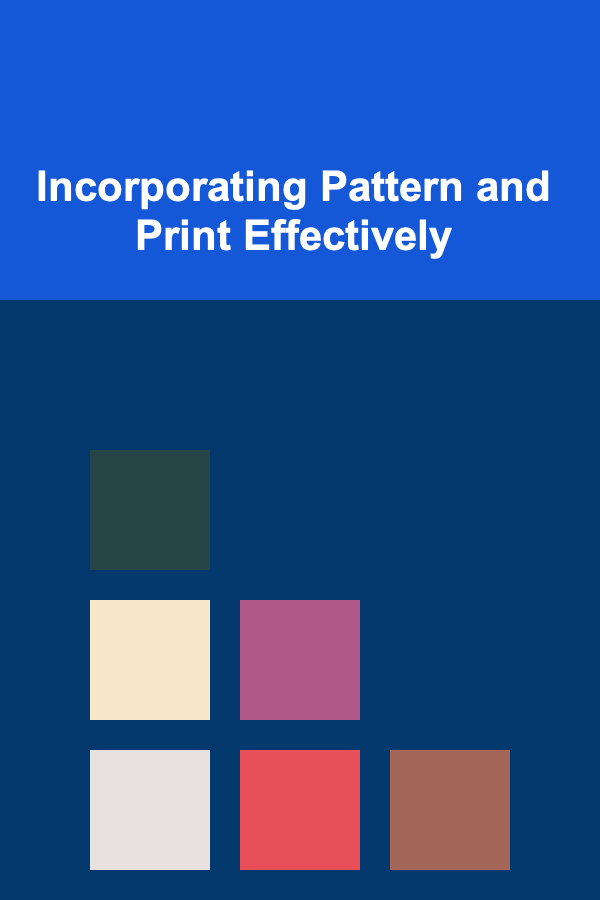
Incorporating Pattern and Print Effectively
ebook include PDF & Audio bundle (Micro Guide)
$12.99$10.99
Limited Time Offer! Order within the next:

Patterns and prints are powerful tools for adding personality, visual interest, and depth to any space, whether it's an interior design project, a wardrobe, or a graphic design composition. However, using them effectively requires a thoughtful approach, balancing boldness with subtlety, and understanding the underlying principles of design. Overuse or misuse of patterns and prints can lead to a chaotic and overwhelming result, while a well-considered application can elevate a design to new heights. This article explores the principles and practical strategies for incorporating patterns and prints effectively, offering guidance for various contexts and applications.
Understanding the Fundamentals
Before diving into specific techniques, it's crucial to grasp the fundamental elements that contribute to successful pattern and print integration:
- Scale: The size of the pattern relative to the surrounding elements. A large-scale floral print on a small accent chair can feel overwhelming, while a tiny, intricate pattern on a large sofa might get lost. Consider the size of the space or object and choose a scale that complements it.
- Color Palette: The colors used in the pattern. The color palette should harmonize with the existing color scheme of the space or outfit. Consider the overall mood you want to create and choose colors that evoke that feeling. You can opt for complementary colors for a bold statement or analogous colors for a more cohesive look.
- Texture: The perceived or actual surface quality of the pattern. Texture can be created through the weave of the fabric, the application of paint, or even the design of the pattern itself. Mixing textures can add depth and interest to a design. For example, pairing a smooth geometric print with a nubby woven fabric can create a dynamic contrast.
- Density: The amount of pattern coverage. A high-density pattern will appear more visually busy than a low-density pattern. Consider the visual weight you want to create and choose a density that achieves that effect.
- Style: The overall aesthetic of the pattern. Is it geometric, floral, abstract, or something else? The style of the pattern should align with the overall style of the design. For example, a modern minimalist space might benefit from a clean geometric pattern, while a bohemian-inspired room could embrace a more eclectic mix of patterns.
- Balance: The distribution of visual weight in a design. Patterns and prints can add significant visual weight, so it's important to balance them with simpler elements. Use solid colors, negative space, and strategic placement to create a sense of equilibrium.
Strategic Placement and Proportion
The placement and proportion of patterns and prints are just as important as the patterns themselves. Here's how to approach them strategically:
1. The Anchor Piece
Start with an "anchor piece" -- a prominent item that features a significant pattern or print. This could be a sofa, a rug, a statement wall, or a large piece of artwork. The anchor piece sets the tone for the entire design and provides a foundation for layering other patterns.
Example: The Floral Sofa
Imagine a living room with a large floral sofa as the anchor piece. The color palette of the sofa (e.g., blues, greens, and creams) dictates the color scheme for the rest of the room. Other elements, like throw pillows, curtains, and artwork, can then incorporate smaller patterns or solid colors that complement the sofa's design.
2. Varying Scale and Type
Avoid using the same pattern or similar patterns repeatedly throughout a space. Instead, mix and match patterns with different scales and styles to create visual interest and prevent a monotonous look. A good rule of thumb is to use a large-scale pattern, a medium-scale pattern, and a small-scale pattern.
Example: Mixing Geometric and Floral
Consider a bedroom with a large-scale floral wallpaper (the anchor). You could then introduce a medium-scale geometric print on throw pillows and a small-scale striped pattern on a decorative rug. The varying scales and styles create a dynamic and visually engaging composition.
3. Using Solid Colors as Breaks
Solid colors provide visual relief and prevent patterns from clashing or overwhelming the space. Use solid-colored furniture, walls, or accessories to create "breaks" between patterned elements. This allows the patterns to stand out and prevents the design from feeling too busy.
Example: The Solid-Colored Rug
In a room with patterned wallpaper and patterned curtains, a solid-colored rug can act as a grounding element, providing a visual anchor and preventing the room from feeling chaotic. Choose a color that complements the overall color scheme but doesn't compete with the patterns.
4. The 60-30-10 Rule
This is a classic interior design guideline that can be helpful for balancing colors and patterns. It suggests allocating 60% of the space to a dominant color or pattern, 30% to a secondary color or pattern, and 10% to an accent color or pattern. This creates a harmonious balance and prevents any single element from dominating the design.
Example: Applying the 60-30-10 Rule
In a living room, 60% could be a solid-colored wall, 30% could be a patterned sofa, and 10% could be patterned throw pillows. The proportions ensure that the patterns are balanced and don't overwhelm the space.
5. Consider the Function of the Space
The function of the space should influence your choice of patterns and their placement. For example, a busy pattern might be stimulating in a home office but distracting in a bedroom. Consider the mood you want to create in the space and choose patterns that support that feeling.
Example: Bedroom Patterns for Relaxation
For a relaxing bedroom, opt for calming patterns like soft florals, subtle stripes, or abstract watercolors in muted colors. Avoid overly stimulating patterns like bold geometric designs or clashing color combinations.
Color Harmony and Contrast
Color is a fundamental aspect of pattern and print design. Understanding color theory can help you create visually appealing and harmonious combinations.
1. Monochromatic Palettes
A monochromatic palette uses different shades and tints of a single color. This creates a sophisticated and cohesive look. You can introduce subtle patterns within the same color family to add visual interest without overwhelming the space.
Example: A Blue Monochromatic Bedroom
A bedroom with walls painted in a light blue, bedding in a darker shade of blue with a subtle striped pattern, and throw pillows in various shades of blue with different textures creates a calming and unified aesthetic.
2. Analogous Palettes
An analogous palette uses colors that are next to each other on the color wheel (e.g., blue, blue-green, and green). This creates a harmonious and visually pleasing combination. You can use patterns that incorporate these analogous colors to create a sense of flow and continuity.
Example: An Analogous Living Room
A living room with walls painted in a warm yellow, furniture upholstered in a golden orange, and accessories in a reddish-orange creates a welcoming and inviting atmosphere. Patterns that incorporate these colors can further enhance the warm and inviting feel.
3. Complementary Palettes
A complementary palette uses colors that are opposite each other on the color wheel (e.g., blue and orange, red and green). This creates a high-contrast and visually dynamic combination. Use complementary colors sparingly in patterns, as they can be quite intense. A good approach is to use one color as the dominant hue and the other as an accent.
Example: A Blue and Orange Accent
A room with predominantly blue walls and furniture can be enlivened with a few orange throw pillows or a piece of artwork featuring orange accents. The complementary colors create a visual pop and add energy to the space.
4. Neutral Backgrounds
If you're unsure about combining colors, a neutral background is always a safe bet. Neutral colors like white, gray, beige, and black provide a blank canvas for showcasing patterns and prints. You can then introduce pops of color through patterned accessories or artwork.
Example: A Neutral Living Room with Patterned Pillows
A living room with white walls, a gray sofa, and a neutral-colored rug can be easily customized with patterned throw pillows in various colors and styles. The neutral background allows the pillows to stand out and become the focal point of the room.
5. Consider the Undertones
When choosing colors for patterns, pay attention to their undertones. Undertones are the subtle hues that lie beneath the surface color. For example, a seemingly "cool" gray might have blue undertones, while a "warm" gray might have yellow undertones. Mixing colors with conflicting undertones can create a jarring effect. Ensure that the undertones of your colors harmonize with each other.
Pattern Mixing Strategies
Mixing patterns can be daunting, but with the right approach, it can be incredibly rewarding. Here are some proven strategies:
1. Vary the Scale
As mentioned earlier, varying the scale of your patterns is crucial for creating visual interest. Combine a large-scale pattern (e.g., a bold floral), a medium-scale pattern (e.g., a geometric print), and a small-scale pattern (e.g., a subtle stripe or dot). This creates a dynamic and layered look.
2. Use a Common Color Palette
Even if the patterns are different in style, a shared color palette can tie them together and create a cohesive look. Choose patterns that feature similar colors or complementary colors to ensure that they harmonize.
3. Incorporate Texture
Mixing textures can add depth and interest to your pattern combinations. Pair smooth patterns with textured fabrics or materials. For example, a smooth geometric print on a silk pillow paired with a textured woven throw blanket. The contrast in texture adds another layer of visual appeal.
4. Embrace Stripes
Stripes are a versatile pattern that can be easily incorporated into almost any design. They can act as a neutral background or a bold accent, depending on their width and color. Stripes can also be used to break up other patterns and create a sense of order.
5. Don't Be Afraid to Experiment
The best way to learn how to mix patterns effectively is to experiment. Gather swatches of different patterns and try combining them in different ways. Take photos of your combinations and analyze what works and what doesn't. Don't be afraid to break the rules and create your own unique combinations.
6. Start Small
If you're hesitant about mixing patterns, start small. Introduce patterns gradually, starting with throw pillows or small accessories. This allows you to experiment and adjust your approach without making a major commitment.
Example: Patterned Throw Pillows
On a solid-colored sofa, you can start with two or three patterned throw pillows. Try combining a floral pillow, a geometric pillow, and a solid-colored pillow with a textured fabric. Observe how the patterns interact and adjust your selections as needed.
7. Ground with Neutrals
When mixing patterns, using neutral colors as a grounding element is essential. A neutral sofa, rug, or wall color can provide a visual anchor and prevent the patterns from overwhelming the space. The neutral colors allow the patterns to shine without competing with each other.
Contextual Considerations
The effectiveness of patterns and prints depends heavily on the context in which they are used. Consider the following factors:
1. Interior Design
In interior design, patterns and prints can be used to create a wide range of moods and styles. Consider the size of the room, the amount of natural light, and the overall design aesthetic when choosing patterns. For example, small rooms benefit from smaller-scale patterns and lighter colors, while larger rooms can handle bolder patterns and darker colors.
2. Fashion
In fashion, patterns and prints can be used to express personal style and make a statement. Consider your body type, skin tone, and personal preferences when choosing patterns. Avoid wearing patterns that are too overwhelming or unflattering. Mix and match patterns strategically to create a unique and stylish look.
3. Graphic Design
In graphic design, patterns and prints can be used to add visual interest and texture to layouts. Consider the overall message and target audience when choosing patterns. Use patterns sparingly to avoid distracting from the main content. Ensure that the patterns are legible and do not interfere with the readability of the text.
4. Web Design
In web design, patterns and prints can be used to create visually appealing backgrounds and accents. However, it's crucial to use them sparingly to avoid slowing down page load times and distracting from the content. Use subtle patterns and textures that complement the overall design and enhance the user experience.
Emerging Trends in Pattern and Print
The world of pattern and print is constantly evolving. Staying abreast of emerging trends can help you create designs that are fresh and relevant. Here are a few trends to watch:
1. Biophilic Design
Biophilic design incorporates elements of nature into the built environment. Patterns inspired by nature, such as botanical prints, floral motifs, and organic textures, are increasingly popular. These patterns bring a sense of calm and tranquility to spaces, connecting people with the natural world.
2. Geometric Abstraction
Geometric abstraction is a style that combines geometric shapes with abstract patterns. This creates a visually stimulating and dynamic aesthetic. Geometric abstraction can be used in a variety of applications, from interior design to graphic design.
3. Sustainable Patterns
With growing concerns about environmental sustainability, there is an increasing demand for patterns made from sustainable materials. This includes patterns printed on organic cotton, recycled fabrics, and using eco-friendly dyes. Sustainable patterns allow you to create beautiful designs without harming the environment.
4. Digital Prints
Digital printing technology allows for the creation of incredibly detailed and complex patterns. Digital prints can be used on a variety of materials, from fabrics to wallpaper. This opens up new possibilities for creating unique and personalized designs.
5. Maximalism
Moving away from minimalist trends, maximalism embraces abundance and eclecticism. Layering patterns, textures, and colors is key to achieving a maximalist aesthetic. This trend allows for a bold and expressive use of patterns and prints.
Conclusion
Incorporating patterns and prints effectively is an art that requires a blend of understanding design principles, a keen eye for color and texture, and a willingness to experiment. By carefully considering the scale, color palette, texture, density, and style of patterns, and by strategically placing and proportioning them within a space or design, you can create visually appealing and harmonious results. Remember to use solid colors as breaks, apply the 60-30-10 rule, and consider the function of the space. Experiment with pattern mixing strategies, embrace emerging trends, and most importantly, trust your intuition. With practice and attention to detail, you can master the art of incorporating patterns and prints and transform ordinary designs into extraordinary expressions of creativity and style.

How to Budget for Fun and Leisure Without Breaking the Bank
Read More
How to Improve Your Home Security with Smart Devices
Read More
How to Stage a Rental Property to Attract High-Quality Tenants
Read More
The Art of Persuasion in Retail: Essential Skills for a Successful Career as a Retail Sales Associate
Read More
How To Find Your Moral Grounding
Read More
How to Create Accessible Social Media Content
Read MoreOther Products

How to Budget for Fun and Leisure Without Breaking the Bank
Read More
How to Improve Your Home Security with Smart Devices
Read More
How to Stage a Rental Property to Attract High-Quality Tenants
Read More
The Art of Persuasion in Retail: Essential Skills for a Successful Career as a Retail Sales Associate
Read More
How To Find Your Moral Grounding
Read More